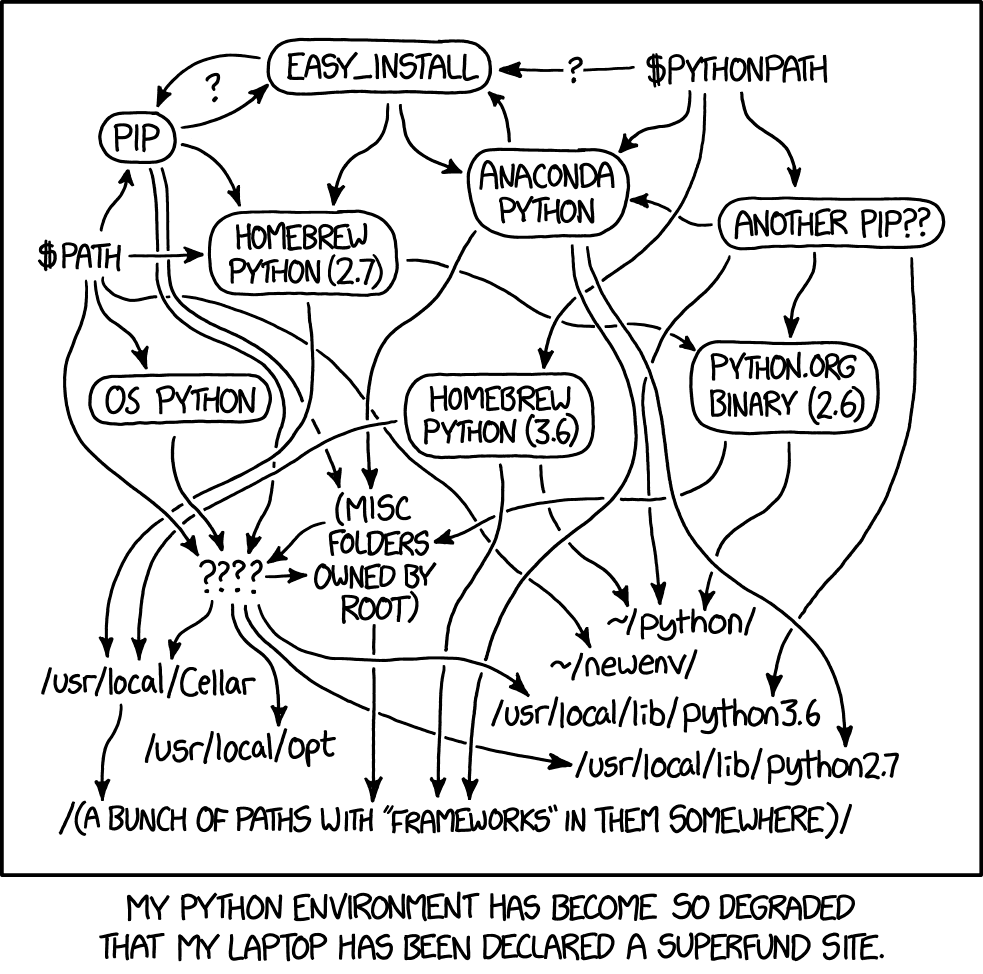FTorch
Facilitating Hybrid Modelling
2025-07-18
Precursors
Slides and Materials
To access links or follow on your own device these slides can be found at:
jackatkinson.net/slides
Licensing
Except where otherwise noted, these presentation materials are licensed under the Creative Commons Attribution-NonCommercial 4.0 International (CC BY-NC 4.0) License.
Vectors and icons by SVG Repo under CC0(1.0) or FontAwesome under SIL OFL 1.1
Motivation
Weather and Climate Models
Large, complex, many-part systems.

Parameteristion
Subgrid processes are largest source of uncertainty


Microphysics by Sisi Chen Public Domain
Staggered grid by NOAA under Public Domain
Globe grid with box by Caltech under Fair use
Parameteristion
Subgrid processes are largest source of uncertainty


Microphysics by Sisi Chen Public Domain
Staggered grid by NOAA under Public Domain
Globe grid with box by Caltech under Fair use
Machine Learning in Science
We typically think of Deep Learning as an end-to-end process;
a black box with an input and an output1.

 Who’s that Pokémon?
Who’s that Pokémon?
\[\begin{bmatrix}\vdots\\a_{23}\\a_{24}\\a_{25}\\a_{26}\\a_{27}\\\vdots\\\end{bmatrix}=\begin{bmatrix}\vdots\\0\\0\\1\\0\\0\\\vdots\\\end{bmatrix}\] It’s Pikachu!
Neural Net by 3Blue1Brown under fair dealing.
Pikachu © The Pokemon Company, used under fair dealing.
Hybrid Modelling

Neural Net by 3Blue1Brown under fair dealing.
Pikachu © The Pokemon Company, used under fair dealing.
Challenges
- Reproducibility
- Ensure net functions the same in-situ
- Re-usability
- Make ML parameterisations available to many models
- Facilitate easy re-training/adaptation
- Language Interoperation
Language interoperation
Many large scientific models are written in Fortran (or C, or C++).
Much machine learning is conducted in Python.





![]()


![]()
Mathematical Bridge by cmglee used under CC BY-SA 3.0
PyTorch, the PyTorch logo and any related marks are trademarks of The Linux Foundation.”
TensorFlow, the TensorFlow logo and any related marks are trademarks of Google Inc.
Possible solutions
- Implement a NN in Fortran
- Additional work, reproducibility issues, hard for complex architectures
- Forpy
- Easy to add, harder to use with ML, GPL, barely-maintained
- SmartSim
- Python ‘control centre’ around Redis: generic/versatile, learning curve, data copying
- Fortran-Keras Bridge
- Keras only, abandonware(?)
Efficiency
We consider 2 types:
Computational
Developer
In research both have an effect on ‘time-to-science’.
Especially when extensive research software support is unavailable.
FTorch
Approach
- PyTorch has a C++ backend and provides an API.
- Binding Fortran to C is straightforward1 from 2003 using
iso_c_binding.
We will:
- Save the PyTorch models in a portable Torchscript format
- to be run by
libtorchC++
- to be run by
- Provide a Fortran API
- wrapping the
libtorchC++ API - abstracting complex details from users
- wrapping the
Approach





Python
env
Python
runtime



xkcd #1987 by Randall Munroe, used under CC BY-NC 2.5

Highlights - Developer
- Easy to clone and install
- CMake, supported on linux/unix and Windows™
- Easy to link
Build using CMake,
or link via Make like NetCDF (instructions included)
FCFLAGS += -I<path/to/install>/include/ftorch LDFLAGS += -L<path/to/install>/lib64 -lftorch
Find it on :
Highlights - Developer
- User tools
pt2ts.pyaids users in saving PyTorch models to Torchscript
- Examples suite
- Take users through full process from trained net to Fortran inference
- Full API documentation online at
cambridge-iccs.github.io/FTorch
- FOSS
- licensed under MIT
- contributions from users via GitHub welcome
Find it on :
Highlights - Computation
- Use framework’s implementations directly
- feature and future support, and reproducible
- Make use of the Torch backends for GPU offload
- CUDA, HIP, MPS, and XPU enabled
- Indexing issues and associated reshape1 avoided with Torch strided accessor.
- No-copy access in memory (on CPU).
Find it on :
Highlights - Computation
- Indexing issues and associated reshape1 avoided with Torch strided accessor.
- No-copy access in memory (on CPU).
Find it on :
Some code
Model - Saving from Python
import torch
import torchvision
# Load pre-trained model and put in eval mode
model = torchvision.models.resnet18(weights="IMAGENET1K_V1")
model.eval()
# Create dummmy input
dummy_input = torch.ones(1, 3, 224, 224)
# Save to TorchScript
if trace:
ts_model = torch.jit.trace(model, dummy_input)
elif script:
ts_model = torch.jit.script(model)
frozen_model = torch.jit.freeze(ts_model)
frozen_model.save("/path/to/saved_model.pt")
TorchScript
- Statically typed subset of Python
- Read by the Torch C++ interface (or any Torch API)
- Produces intermediate representation/graph of NN, including weights and biases
tracefor simple models,scriptmore generally
Fortran
use ftorch
implicit none
real, dimension(5), target :: in_data, out_data ! Fortran data structures
type(torch_tensor), dimension(1) :: input_tensors, output_tensors ! Set up Torch data structures
type(torch_model) :: torch_net
integer, dimension(1) :: tensor_layout = [1]
in_data = ... ! Prepare data in Fortran
! Create Torch input/output tensors from the Fortran arrays
call torch_tensor_from_array(input_tensors(1), in_data, torch_kCPU)
call torch_tensor_from_array(output_tensors(1), out_data, torch_kCPU)
call torch_model_load(torch_net, 'path/to/saved/model.pt', torch_kCPU) ! Load ML model
call torch_model_forward(torch_net, input_tensors, output_tensors) ! Infer
call further_code(out_data) ! Use output data in Fortran immediately
! Cleanup
call torch_delete(model)
call torch_delete(in_tensors)
call torch_delete(out_tensor)GPU Acceleration
Cast Tensors to GPU in Fortran:
! Load in from Torchscript
call torch_model_load(torch_net, 'path/to/saved/model.pt', torch_kCUDA, device_index=0)
! Cast Fortran data to Tensors
call torch_tensor_from_array(in_tensor(1), in_data, torch_kCUDA, device_index=0)
call torch_tensor_from_array(out_tensor(1), out_data, torch_kCPU)
FTorch supports NVIDIA CUDA, ARM HIP, Intel XPU, and AppleSilicon MPS hardwares.
Use of multiple devices supported.
Effective HPC simulation requires MPI_Gather() for efficient data transfer.
Publication & tutorials
FTorch is published in JOSS!
Atkinson et al. (2025)
FTorch: a library for coupling PyTorch models to Fortran.
Journal of Open Source Software, 10(107), 7602,
doi.org/10.21105/joss.07602
Please cite if you use FTorch!

In addition to the comprehensive examples in the FTorch repository we provide an online workshop at /Cambridge-ICCS/FTorch-workshop
Applications and Case Studies
MiMA - proof of concept
- The origins of FTorch
- Emulation of existing parameterisation
- Coupled to an atmospheric model using
forpyin Espinosa et al. (2022)1 - Prohibitively slow and hard to implement
- Asked for a faster, user-friendly implementation that can be used in future studies.
- Follow up paper using FTorch: Uncertainty Quantification of a Machine Learning Subgrid-Scale Parameterization for Atmospheric Gravity Waves (Mansfield and Sheshadri 2024)
- “Identical” offline networks have very different behaviours when deployed online.
ICON
- Icosahedral Nonhydrostatic Weather and Climate Model
- Developed by DKRZ (Deutsches Klimarechenzentrum)
- Used by the DWD and Meteo-Swiss
- Interpretable multiscale Machine Learning-Based Parameterizations of Convection for ICON (Heuer et al. 2023)1
- Train U-Net convection scheme on high-res simulation
- Deploy in ICON via FTorch coupling
- Evaluate physical realism (causality) using SHAP values
- Online stability improved when non-causal relations are eliminated from the net

![]()
CESM coupling
- The Community Earth System Model
- Part of CMIP (Coupled Model Intercomparison Project)
- Make it easy for users
- FTorch integrated into the build system (CIME)
libtorchis included on the software stack on Derecho- Improves reproducibility

Derecho by NCAR
Others
- To replace a BiCGStab bottleneck in the GloSea6 Seasonal Forecasting model
(Park and Chung 2025). - Bias correction of CESM through learning model biases compared to ERA5
(Chapman and Berner 2025) - Implementation of nonlinear interactions in the WaveWatch III model
(Ikuyajolu et al. 2025). - Stable embedding of a convection resolving parameterisation in E3SM
(Hu et al. 2025). - Implementation of a new convection trigger in the CAM model.
Miller et al. In Preparation. - Embedding of ML schemes for gravity waves in the CAM model.
ICCS & DataWave.
Online Training and AutogradWork
Work led by Joe Wallwork
What and Why?
To date FTorch has focussed on enabling researchers to run models developed and trained offline within Fortran codes.
However, it is clear (Mansfield and Sheshadri 2024) that more attention to online performance, and options with differentiable/hybrid models (e.g. Kochkov et al. 2024) is becoming important.
Pros:
- Avoids saving large volumes of training data.
- Avoids need to convert between Python and Fortran data formats.
- Possibility to expand loss function scope to include downstream model code.
Cons:
- Difficult to implement in most frameworks.
Expanded Loss function
Suppose we want to use a loss function involving downstream model code, e.g.,
\[J(\theta)=\int_\Omega(u-u_{ML}(\theta))^2\;\mathrm{d}x,\]
where \(u\) is the solution from the physical model and \(u_{ML}(\theta)\) is the solution from a hybrid model with some ML parameters \(\theta\).
Computing \(\mathrm{d}J/\mathrm{d}\theta\) requires differentiating Fortran code as well as ML code.
Implementing AD in FTorch
- Expose
autogradfunctionality from Torch.- e.g.,
requires_gradargument andbackwardmethods.
- e.g.,
- Overload mathematical operators (
=,+,-,*,/,**).
Using AD - FTorch
use ftorch
type(torch_tensor) :: a, b, Q, multiplier, divisor, dQda, dQdb
real, dimension(2), target :: Q_arr, dQda_arr, dQdb_arr
! Construct input tensors with requires_grad=.true.
call torch_tensor_from_array(a, [2.0, 3.0], torch_kCPU, requires_grad=.true.)
call torch_tensor_from_array(b, [6.0, 4.0], torch_kCPU, requires_grad=.true.)
! Workaround for scalar multiplication and division using 0D tensors
call torch_tensor_from_array(multiplier, [3.0], torch_kCPU)
call torch_tensor_from_array(divisor, [3.0], torch_kCPU)
! Compute some mathematical expression
call torch_tensor_from_array(Q, Q_arr, torch_kCPU)
Q = multiplier * (a**3 - b * b / divisor)
! Reverse mode
call torch_tensor_backward(Q)
call torch_tensor_from_array(dQda, dQda_arr, torch_kCPU)
call torch_tensor_from_array(dQdb, dQdb_arr, torch_kCPU)
call torch_tensor_get_gradient(a, dQda)
call torch_tensor_get_gradient(b, dQdb)
print *, dQda_arr
print *, dQdb_arrOptimizers and loss functions
- Optimizers
- Expose
torch::optim::SGD,torch::optim::AdamWetc., as well aszero_gradandstepmethods. - This already enables some cool AD applications in FTorch.
- Expose
- Loss functions
- We haven’t exposed any built-in loss functions yet.
- Implemented
torch_tensor_sumandtorch_tensor_mean, though.
Putting it together - running an optimiser in FTorch
\[\begin{bmatrix}f_1\\f_2\\f_3\\f_4\end{bmatrix}=\mathbf{f}(\mathbf{x};\mathbf{a})=\mathbf{a}\bullet\mathbf{x}\equiv\begin{bmatrix}a_1x_1\\a_2x_2\\a_3x_3\\a_4x_4\end{bmatrix}\] Starting from \(\mathbf{a}=\mathbf{x}:=\begin{bmatrix}1,1,1,1\end{bmatrix}^T\), optimise the \(\mathbf{a}\) vector such that \(\mathbf{f}(\mathbf{x};\mathbf{a})=\mathbf{b}:=\begin{bmatrix}1,2,3,4\end{bmatrix}^T\).
Loss function: \(\ell(\mathbf{a})=\overline{(\mathbf{f}(\mathbf{x};\mathbf{a})-\mathbf{b})^2}\).
Putting it together - running an optimiser in FTorch

In both cases we achieve \(\mathbf{f}(\mathbf{x};\mathbf{a})=\begin{bmatrix}1,2,3,4\end{bmatrix}^T\).
Case study - UKCA
- Implicit timestepping, quasi-Newton, full LU decomposition.
- For each time subinterval to be integrated:
- Start with \(\Delta t=3600\).
- Try to integrate with the current timestep size.
- If any grid-box fails, half the step and try again.
- A nice ‘safe’ application of machine learning in modelling
Summary
- Use of ML within traditional numerical models
- A growing area that presents challenges
- Language interoperation
- FTorch provides a solution for scientists looking to implement torch models in Fortran
- Designed with both computational and developer efficiency in mind
- Has helped deliver science in climate research and beyond
(Heuer et al. (2023), Mansfield and Sheshadri (2024)) - Built into CESM to allow the userbase access
- FTorch is exploring options for online training and AD
- Torch
autogradfunctionality exposed usingiso_c_binding. - Exposed tools for optimization.
- Work in progress on setting up online ML training.
- Torch
Thanks for Listening
Get in touch:
Find it on :
Thanks to Joe Wallwork, Tom Metlzer, Elliott Kasoar
and the rest of the FTorch team.
FTorch has been supported by 
The ICCS received support from 

References


